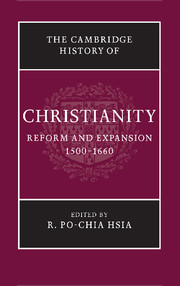Book contents
- Frontmatter
- Part I Luther and the Holy Roman Empire
- Part II The Second Reformation
- Part III Catholic Renewal
- 9 Redefining Catholicism: Trent and Beyond
- 10 New religious orders for men
- 11 Female sanctity, 1500–1660
- 12 Tridentine worship and the cult of saints
- Part IV Resolving Confessional Conflicts
- Part V Religion, Society, and Culture
- Part VI Christianity and Other Faiths
- Bibliography
- Index
- References
10 - New religious orders for men
from Part III - Catholic Renewal
Published online by Cambridge University Press: 28 March 2008
- Frontmatter
- Part I Luther and the Holy Roman Empire
- Part II The Second Reformation
- Part III Catholic Renewal
- 9 Redefining Catholicism: Trent and Beyond
- 10 New religious orders for men
- 11 Female sanctity, 1500–1660
- 12 Tridentine worship and the cult of saints
- Part IV Resolving Confessional Conflicts
- Part V Religion, Society, and Culture
- Part VI Christianity and Other Faiths
- Bibliography
- Index
- References
Summary
Introduction
Historians stress what is new in history, so the new religious orders of the Catholic Reformation attract more attention than reform movements in the older traditional orders of monks and friars. Since these older orders were much larger than most new orders, their efforts to reform probably contributed even more to reforming Catholicism. Some older orders, however, virtually disappeared. The crusading orders in Baltic lands, Spain and Portugal largely lost their reason for existence, and civic rulers took over most of their assets. Many bishops and cardinals felt that religious orders should be phased out altogether or amalgamated into four or so different types. Many bishops hated the exemptions from episcopal control and the privileges the papacy had conferred on the orders. Despite such attitudes, the period saw the creation of new male and female orders and congregations that reshaped Catholicism in the next 500 years.
The creation of new religious orders is usually a sign of Catholic vitality. The thirteenth century saw five new major orders of friars. The aftermath of the French Revolution and Napoleon saw dozens of new orders, especially of women. The fifteenth century was almost barren, while this chapter traces the rise of eighteen men’s orders during the Catholic Reformation. None of these new orders were started by popes and few by bishops. Their founders were sometimes priests, sometimes laymen, who saw social and religious needs and gathered followers to answer those needs. Except possibly for the Spanish Discalced Carmelites, all the new orders stressed active ministry more than prayer, although none saw work and prayer as either/or alternatives.
- Type
- Chapter
- Information
- The Cambridge History of Christianity , pp. 162 - 179Publisher: Cambridge University PressPrint publication year: 2007



